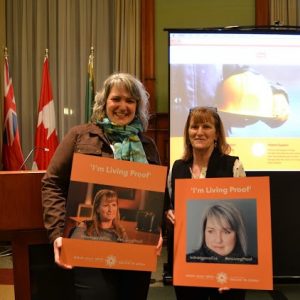Guest post by Natalie Richardson
Until last year I thought the phrase “patient advocacy” was terminology for action that other people take in the distant lots of big city hospitals, or with pickets across Parliament Hill. People throwing big words at medical problems, fighting for the sick or the silenced, major meetings in far-away boardrooms deciding how millions of pharmaceutical dollars would be spent on some ambiguous research study. Things that really didn’t apply to me.
Quickly I have learned that patient advocacy is a term much closer to home, and it is not obscure at all.
 It happens all across Canada and the world, and it applies to anyone experiencing a health situation in any form. It is what people do when they bring awareness to a medical occurrence. Whenever a patient, or a family member or health care professional on a patient’s behalf, or a group speaking about a particular disorder lends voice to their concern, they are taking action as an advocate to inform and support, helping patients and their families get access to information and the health services they need.
It happens all across Canada and the world, and it applies to anyone experiencing a health situation in any form. It is what people do when they bring awareness to a medical occurrence. Whenever a patient, or a family member or health care professional on a patient’s behalf, or a group speaking about a particular disorder lends voice to their concern, they are taking action as an advocate to inform and support, helping patients and their families get access to information and the health services they need.
Patient advocacy helps someone like myself for example, in the methods that a group such as Save Your Skin Foundation uses, to ensure people with melanoma and other skin cancers have access to all of the treatments and health services they need.
Even though the field of melanoma treatment is rapidly growing this day in age, patients still struggle with receiving timely access to new medications as they are discovered, quite often due to budgetary constraints.
Bringing voice to these real and urgent concerns is important in shaping public opinion about issues, since public opinion is the major driver of government policy. By highlighting a subject to a government party or representative(s), there is at least a chance that a portion of funding may be viewed necessary to facilitate the completion or approval of a new treatment or development in care for the given subject, in this case a deadly disease.
There are several ways to carry out patient advocacy, as I have learned from Save Your Skin Foundation (SYSF). Meeting with and sending information to government officials is one piece of the puzzle. SYSF even makes it easy to send a letter to provincial representatives as well as the Federal Health Minister, with form letters available on their website easily downloaded from their “Who are You Surviving For” program page. Every letter matters. Speaking engagements and writing pieces, fund raising walks and social media campaigns also contribute to awareness and engagement.
A melanoma diagnosis no longer needs to be considered an automatic death sentence for Canadians, should we be able to receive equal access to treatments as they come along. And I was able to say that out loud just last week at Queen’s Park; I was able to address members of the Legislative Assembly of Ontario personally, along with Save Your Skin Foundation. Face to face I was able to share my experience with the limitations of melanoma treatment as it stands today. The response was warm and caring, and I feel genuinely hopeful that my small part in delivering this message may help myself and others receive timely and equal access to melanoma treatment in future. I feel that somewhere along the path even one of those representatives may remember my face when choosing their voting direction for funding.
I was fortunate to have received the treatment for my metastatic melanoma that I did, solely due to the randomization process in the clinical trial in which I was enrolled. I had only a 50/50 chance of receiving


 It happens all across Canada and the world, and it applies to anyone experiencing a health situation in any form. It is what people do when they bring awareness to a medical occurrence. Whenever a patient, or a family member or health care professional on a patient’s behalf, or a group speaking about a particular disorder lends voice to their concern, they are taking action as an advocate to inform and support, helping patients and their families get access to information and the health services they need.
It happens all across Canada and the world, and it applies to anyone experiencing a health situation in any form. It is what people do when they bring awareness to a medical occurrence. Whenever a patient, or a family member or health care professional on a patient’s behalf, or a group speaking about a particular disorder lends voice to their concern, they are taking action as an advocate to inform and support, helping patients and their families get access to information and the health services they need.






